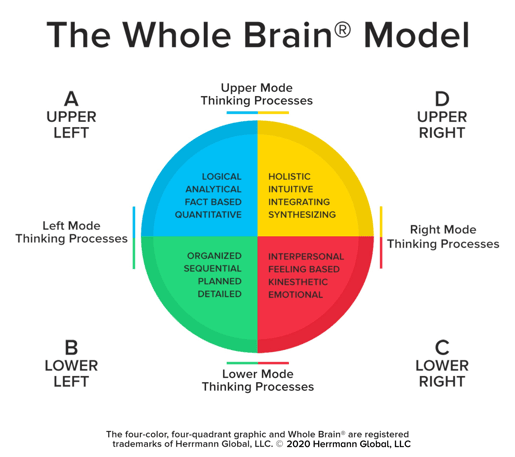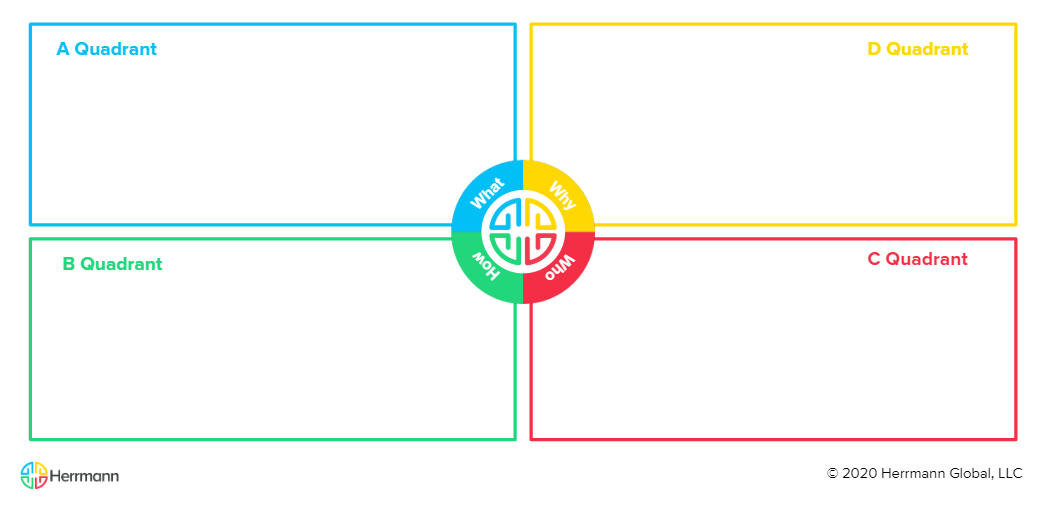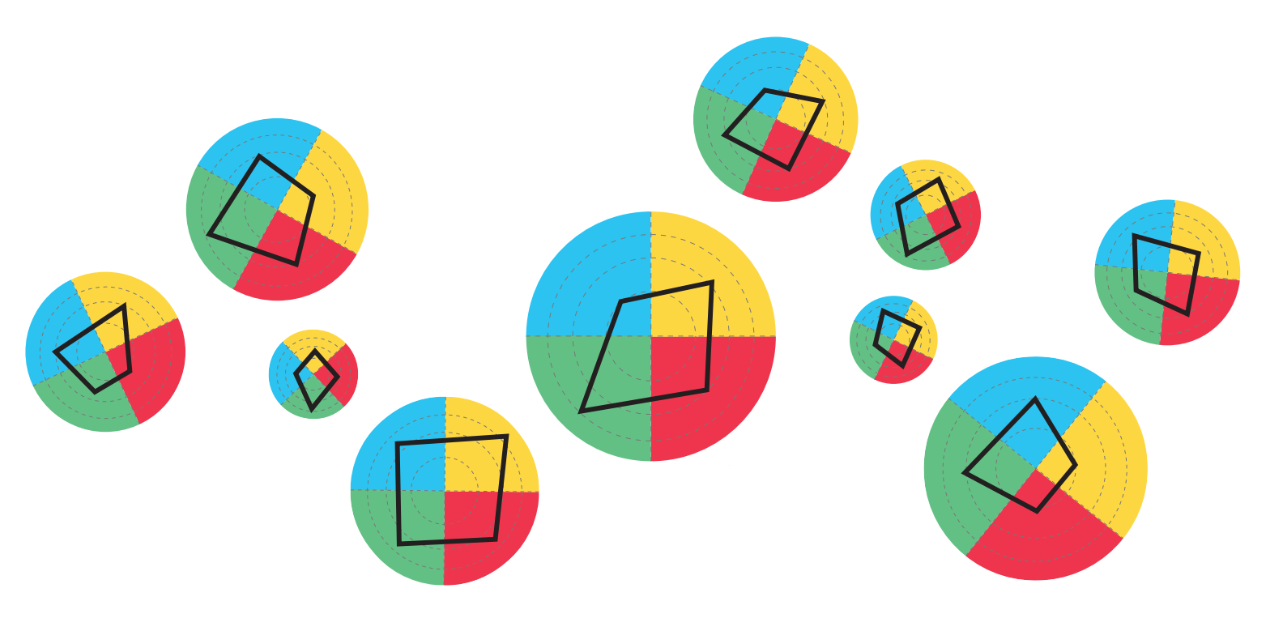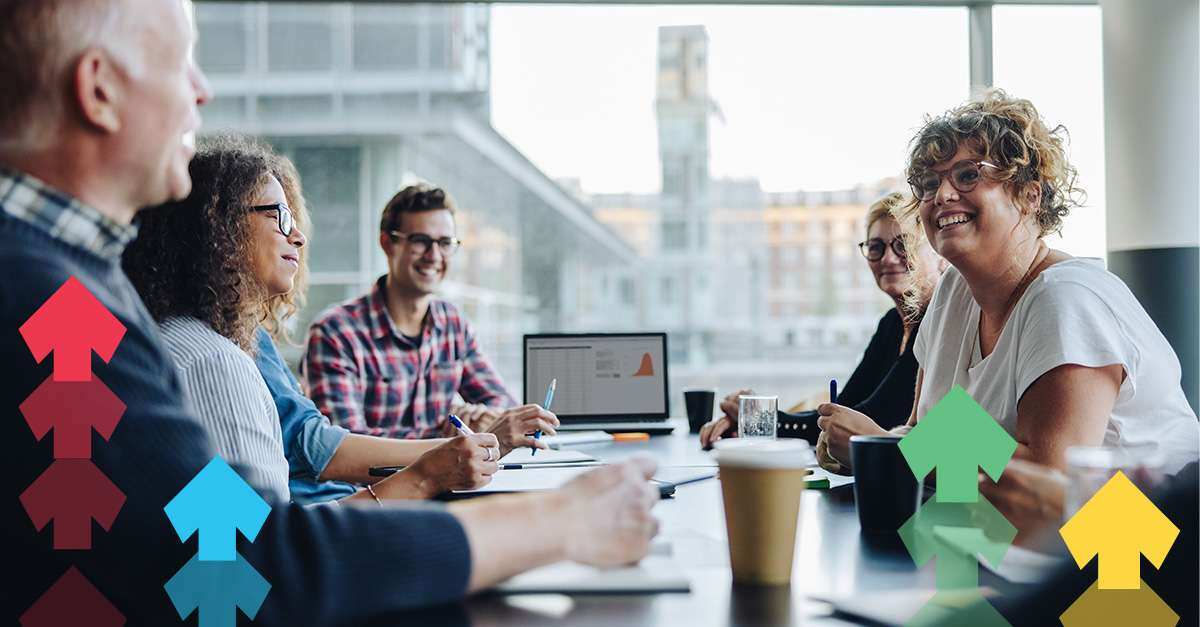Managing stress during this COVID-19 crisis is definitely easier said than done. We all have different ways of thinking and processing information. Therefore, it makes sense that we all have different ways of internalizing and reacting to stress.
At Herrmann we often leverage our Whole Brain® WalkAround tool to facilitate meetings, prompt conversations, launch projects, and more. The Whole Brain® WalkAround is a diagnostic tool meant for understanding, prompting, diagnosing, charting or planning different approaches based on the four quadrants of Herrmann's Whole Brain® Model. It can be used both in your personal or professional life.
As a refresher or for familiarization, feel free to reference our Whole Brain® Model for context around the "quadrants" that will be referenced.

While coping amidst the COVID-19 pandemic, you can use the Whole Brain® WalkAround to consciously examine your stress through the lens of each quadrant. This exercise provides the opportunity to observe the facts, develop a plan of action, connect and align with your team or family, and begin to plan future steps and goals.
Give it a shot: Place your thoughts inside of the WalkAround model – move one quadrant at a time. (Scroll down for more information on quadrants.) As you plot your thoughts, deliberately think of the what, how, who and why that pertain to your situation. In doing so, you may very well gain a better understanding of how to handle the ebb and flow of that stress during these challenging times.

When you craft your WalkAround, you may find the following questions helpful as you mentally "walk around" each quadrant starting with A and moving counterclockwise to B, C and finally D.
Whole Brain® Thinking During the COVID-19 Pandemic:
A Quad: Information and Knowledge
- What verifiable data, facts and numbers do I have at this time?
- What is the latest scientific cause and effects research data verifying?
- What are the impacts and consequences of the current situation?
- What problems and challenges are my top priorities?
- What state-of-the-art technology can be leveraged to solve our problems?
Answer these questions as best you can to understand the “what” surrounding the COVID-19 pandemic. You need accurate, up-to-date scientific information about the illness in order to make informed decisions about how to prevent it. Knowing that you have accurate data, may even alleviate some of your stress.
B Quad: Actions and Plans
- What safe actions and proven precautions should and/or will I take?
- What specific protocols and step-by-step routines will serve me best?
- What are the detailed components of my practical plan?
- What personal boundaries do I need in order to stay safe?
- How committed am I practicing certain disciplines?
Use these questions to put together your personalized plan for “how” you are going to navigate the COVID-19. According to Joseph F. McGuire, M.A., Ph.D., a psychologist with Johns Hopkins Medicine, “If you are stressed about COVID-19, it is important to have an established plan to minimize worries and keep focused on proactive solutions.”
C Quad: Feelings and Relationships
- How are my feelings and concerns affecting me?
- What do I need if I am feeling fearful, depressed, anxious, sad or lonely?
- Who do I want to stay connected with?
- What support would I like from others?
- Who can I help and support during this time?
The outbreak of COVID-19 is surely stressful to most people. Fear and anxiety about a disease can be overwhelming and cause strong emotions in adults and children.
Sign up to our newsletter for the latest insights
D Quad: Choices and the Future
- What if I/we do nothing differently?
- What opportunities and new possibilities are being revealed and/or discovered?
- What potential is ripe for discovery?
- What imaginative strategic changes are being called forth?
- Why novelty, innovation, humor, playfulness and improvisation are relevant at this time?
Since severe stress has been shown to have a negative impact, it is important to think out-of-the-box to deal with it. If you focus on “why” this COVID-19 pandemic may in the future bring about positive outcomes (personally, nationally and globally), you may be better able to cope with the stress you are feeling at the moment.
Interestingly enough, by working through this WalkAround model as it relates to COVID-19, I feel that some of my stress has been reduced. It forced me to clearly think through what the problem was, how I could do something about it, whom it affects, and why it may have a positive effect long term.
My hope is that, by sharing this process, you now have a roadmap and guidance to help overcome at least some of the stress you may be experiencing with this pandemic.
And don’t forget to keep the method at your fingertips for any problem-solving or decision-making challenges that may arise in your future.
This post was a contribution from one of the Herrmann team, Trish Rajewski, Client Experience Coordinator.
For more tips from our company about working from home, download the e-book, "Going Remote: A Whole Brain® Guide For Remote Management & Distributed Productivity."












